Drivers of Stunting Reduction in Yogyakarta, Indonesia: A Case Study
Abstract
1. Introduction
2. Methods
2.1. Study Design
2.2. Quantitative Methods
2.2.1. Data Sources
2.2.2. Outcomes
2.2.3. Setting
2.2.4. Statistical Analysis
2.3. Qualitative Method
2.3.1. Data Source
2.3.2. Setting
2.3.3. Analysis
2.3.4. Ethical Consideration
3. Results
3.1. Characteristic of Sample
3.2. HAZ Kernel Density Plots, HAZ Scores, and Prevalence of Stunting
3.3. Program Intervention
3.4. The Qualitative Results
3.4.1. Overview of Anti-Stunting Policies
3.4.2. Qualitative Inquiry Results from Expert Stakeholders
“All local government organizations have committed to reducing stunting and have carried out 8 convergent stunting actions, but there are still some weaknesses, such as coordination and misperceptions, especially in the non-health sector in efforts to reduce stunting”.
3.4.3. Communities Stake Holders
“Smoking is still an issue that interferes with stunting reduction. Whether it is related to the proportion of food spending for toddlers or aspects of its impact on vulnerable groups, sometimes they still find them smoking freely in the house, smoking while holding their children or smoking near pregnant women”.
“In addition to these factors, we are very constrained in overcoming community-based stunting because mothers do not understand stunting; they deny if their children are called stunted, especially if they belong to a family that is economically good”.
3.4.4. Mothers in Communities
“This pandemic has aggravated the economic situation of the community, especially for informal workers. The decline in income has an impact on food spending, especially on toddler food. For this reason, I really hope that the provision of food assistance from the government will enable me to make a living. We need extra feeding for toddlers and pregnant women so as to prevent stunting”.
4. Discussion
5. Conclusions
Author Contributions
Funding
Institutional Review Board Statement
Informed Consent Statement
Data Availability Statement
Acknowledgments
Conflicts of Interest
References
- UNICEF-WHO-WB. Joint Child Malnutrition Estimates 2021, Geneva, New York, 2021. Available online: https://datatopics.worldbank.org/child-malnutrition/ (accessed on 4 March 2022).
- Ministry of Health Republic Indonesia. Buku Saku Hasil Studi Status Gizi Indonesia Tingkat Nasional, Provinsi dan Kabupaten/Kota Tahun 2021; Ministry of Health Republic Indonesia: Jakarta, Indonesia, 2021.
- Dinas Kesehatan D.I. Yogyakarta, Profil Kesehatan D.I. Yogyakarta Tahun 2021. 2021. Available online: https://dinkes.jogjaprov.go.id/download/download/254 (accessed on 2 February 2022).
- World Health Organization. WHO Director-General’s Opening Remarks at the Media Briefing on COVID-19—11 March 2020; WHO Director General’s Speeches; World Health Organization: Geneva, Switzerland, 2020. [Google Scholar]
- FKKMK UGM. Pulih COVID-19 Gizi. 2020. Available online: https://pkmk-ugm.shinyapps.io/PulihCovidGizi/_w_e759c4a4/ (accessed on 17 June 2021).
- Andari, W.; Siswati, T.; Paramashanti, B.A. Tinggi Badan Ibu sebagai Faktor Risiko Stunting pada Anak Usia 24–59 Bulan di Kecamatan Pleret dan Kecamatan Pajangan, Kabupaten Bantul, Yogyakarta. J. Nutr. Coll. 2020, 9, 235–240. [Google Scholar] [CrossRef]
- Astuti, D.P.; Utami, W.; Sulastri, E. Pencegahan Stunting Melalui Kegiatan Penyuluhan Gizi Balita dan Pemberian Makanan Tambahan Berbasis Kearifan Lokal di Posyandu Desa Madureso. Univ. Res. Colloq. 2020, 2020, 74–79. [Google Scholar]
- Warsini, K.T.; Hadi, H.; Nurdiati, D.S. Riwayat KEK dan Anemia pada Ibu Hamil Tidak Berhubungan dengan Kejadian Stunting pada Anak Usia 6–23 bulan di Kecamatan Sedayu, Bantul, Yogyakarta. J. Gizi Dan Diet. Indones. 2016, 4, 29. [Google Scholar] [CrossRef][Green Version]
- Khasanah, D.P.; Hadi, H.; Paramashanti, B.A. Waktu Pemberian Makanan Pendamping ASI (MP-ASI) Berhubungan dengan Kejadian Stunting Anak Usia 6–23 bulan di Kecamatan Sedayu. J. Gizi Dan Diet. Indones. 2016, 4, 105–111. [Google Scholar] [CrossRef] [PubMed]
- Lestari, E.F.; Dwihestie, L.K. ASI Eksklusif Berhubungan dengan Kejadian Stunting pada Balita. J. Ilm. Permas J. Ilm. 2020, 10, 129–136. [Google Scholar]
- Handayani, S.; Kapota, W.N.; Oktavianto, E. Hubungan Status Asi Eksklusif dengan Kejadian Stunting pada Batita Usia 24–36 Bulan di Desa Watugajah Kabupaten Gunungkidul. Med. Respati J. Ilm. Kesehat. 2019, 14, 287. [Google Scholar] [CrossRef]
- Kattan, M. Makanan Pendamping Asi Menurunkan Kejadian Stunting Pada Balita Kabupaten Sleman. JIKA 2019, 3, 23–28. [Google Scholar] [CrossRef]
- Resti, E.; Wandini, R.; Rilyani, R. Pemberian Makanan Pendamping ASI (MP-ASI) Berhubungan dengan Kejadian Stunting pada Balita. J. Kebidanan Malahayati 2021, 7, 274–278. [Google Scholar] [CrossRef]
- Nurlianna, F.; Siswati, T.; Oktasari, R. Mapping of Economic Status with Malnutrition of the Children Age 0–59 Months. Kemas Indones 2021, 13, 111–125. [Google Scholar]
- National Development Planning Agency. The National Medium-Term Plan (RPJMN) for 2022–2024; Bappenas: Jakarta, Indonesia, 2020. [Google Scholar]
- TNP2K. Strategi Nasional Percepatan Pencegahan Stunting 2018–2024; TNP2K: Jakarta, Indonesia, 2018. [Google Scholar]
- Gani, A.A.; Hadju, V.; Syahruddin, A.N.; Otuluwa, A.S.; Palutturi, S.; Thaha, A.R. The effect of convergent action on reducing stunting prevalence in under-five children in Banggai District, Central Sulawesi, Indonesia. Gac. Sanit. 2021, 35, S421–S424. [Google Scholar] [CrossRef]
- Absori, A.; Hartotok, H.; Dimyati, K.; Nugroho, H.S.W.; Budiono, A.; Rizka, R. Public Health-Based Policy on Stunting Prevention in Pati Regency, Central Java, Indonesia. Open Access Maced. J. Med. Sci. 2022, 10, 259–263. [Google Scholar] [CrossRef]
- UNICEF. Scalling Up Nutrition. 2011. Available online: https://scalingupnutrition.org/ (accessed on 2 February 2022).
- World Bank. Aiming High. Indonesia’s Ambition to Reduce Stunting. Angew. Chem. Int. Ed. 2018, 6, 951–952. [Google Scholar]
- Ruel, M.T.; Alderman, H. Nutrition-Sensitive Interventions and Programmes: How Can They Help to Accelerate Progress in Improving Maternal and Child Nutrition? Lancet 2013, 382, 536–551. [Google Scholar] [CrossRef] [PubMed]
- Macella, A.D.R.; Mardhiah, N.; Handayani, S.W. A Study of Leadership Innovation in Stunting Prevention and Handling in Simeulue, Aceh Province, Indonesia. Int. J. Adv. Soc. Sci. Humanit. 2022, 1, 50–57. [Google Scholar] [CrossRef]
- World Health Organization. Childhood Stunting: Challenges and Opportunities; Report of a Promoting Healthy Growth and Preventing Childhood Stunting Colloquium; WHO: Geneva, Switzerland, 2014; p. 34. [Google Scholar]
- De Onis, M.; Dewey, K.G.; Borghi, E.; Onyango, A.W.; Blössner, M.; Daelmans, B.; Piwoz, E.; Branca, F. The World Health Organization’s global target for reducing childhood stunting by 2025: Rationale and proposed actions. Matern. Child Nutr. 2013, 9, 6–26. [Google Scholar] [CrossRef]
- Patwari, A.K.; Kumar, S.; Beard, J. Undernutrition among infants less than 6 months of age: An underestimated public health problem in India. Matern. Child Nutr. 2013, 11, 119–126. [Google Scholar] [CrossRef]
- Lillepold, K.; Aimone, A.; Keino, S.; Braitstein, P. Assessing the effect of drought severity on height-for-age z-score in Kenyan children: A secondary analysis. Lancet Planet. Health 2018, 2, S13. [Google Scholar] [CrossRef]
- Gupta, A.; Cleland, J.; Sekher, T.V. Effects of parental stature on child stunting in India. J. Biosoc. Sci. 2021, 54, 605–616. [Google Scholar] [CrossRef]
- Fotso, J.-C. Child health inequities in developing countries: Differences across urban and rural areas. Int. J. Equity Health 2006, 5, 9. [Google Scholar] [CrossRef]
- Zhu, W.; Zhu, S.; Sunguya, B.; Huang, J. Urban–Rural Disparities in the Magnitude and Determinants of Stunting among Children under Five in Tanzania: Based on Tanzania Demographic and Health Surveys 1991–2016. Int. J. Environ. Res. Public Health 2021, 18, 5184. [Google Scholar] [CrossRef]
- Perkins, J.M.; Subramanian, S.; Smith, G.D.; Özaltin, E. Adult height, nutrition, and population health. Nutr. Rev. 2016, 74, 149–165. [Google Scholar] [CrossRef] [PubMed]
- President Republic Indonesia. Presidential Regulation no 72 Year 2021 Issue Stunting Reduction Acceleration. 2021. Available online: https://peraturan.bpk.go.id/Home/Details/174964/perpres-no-72-tahun-2021 (accessed on 1 February 2022).
- Orellana, J.D.Y.; Gatica-Domínguez, G.; Vaz, J.D.S.; Neves, P.A.R.; de Vasconcellos, A.C.S.; Hacon, S.D.S.; Basta, P.C. Intergenerational Association of Short Maternal Stature with Stunting in Yanomami Indigenous Children from the Brazilian Amazon. Int. J. Environ. Res. Public Health 2021, 18, 9130. [Google Scholar] [CrossRef] [PubMed]
- Biro Hukum Pemerintah Daerah Yogyakarta. Peraturan Gubernur Daerah Istimewa Yogyakarta Nomor 92 Tehun 2020 Tentang Rencana Aksi Daerah Pencegahan Dan Penanganan Stunting Daerah Istimewa Yogyakarta Tahun 2020–2024. no. 6. 2020. Available online: http://birohukum.jogjaprov.go.id/storage/15891_2020pg0034092.pdf (accessed on 23 April 2022).
- Dinas Kesehatan Kabupaten Sleman. Keputusan Kepala Dinas Kabupaten Sleman No 188/77/2021. Petunjuk Teknis Pelaksanaan Program Inovasi Untuk Percepatan Penanggulangan Stunting Terintegrasi di Kabupaten Sleman; Dinas Kesehatan Kabupaten Sleman: Yogyakarta, Indonesia, 2021. [Google Scholar]
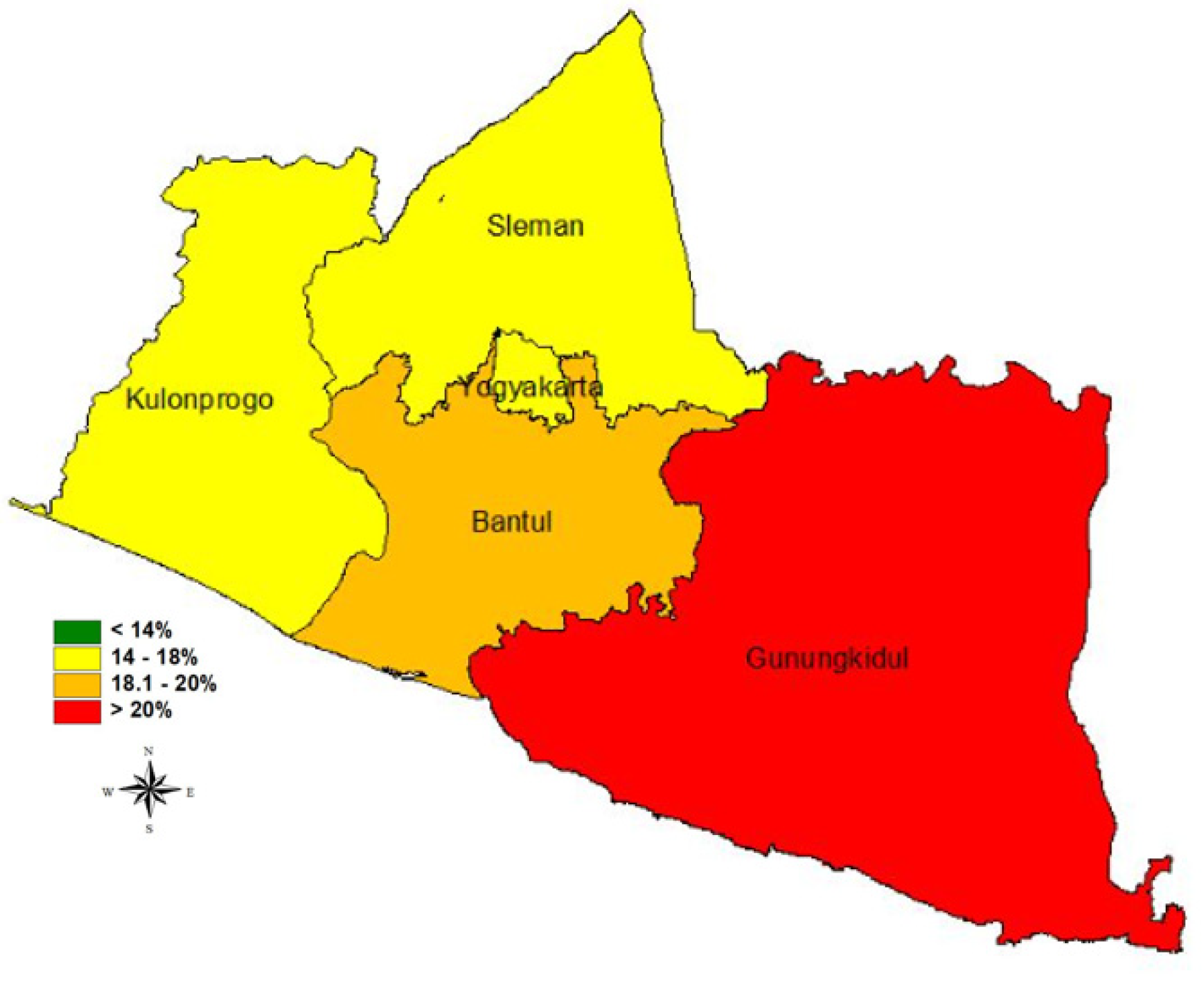
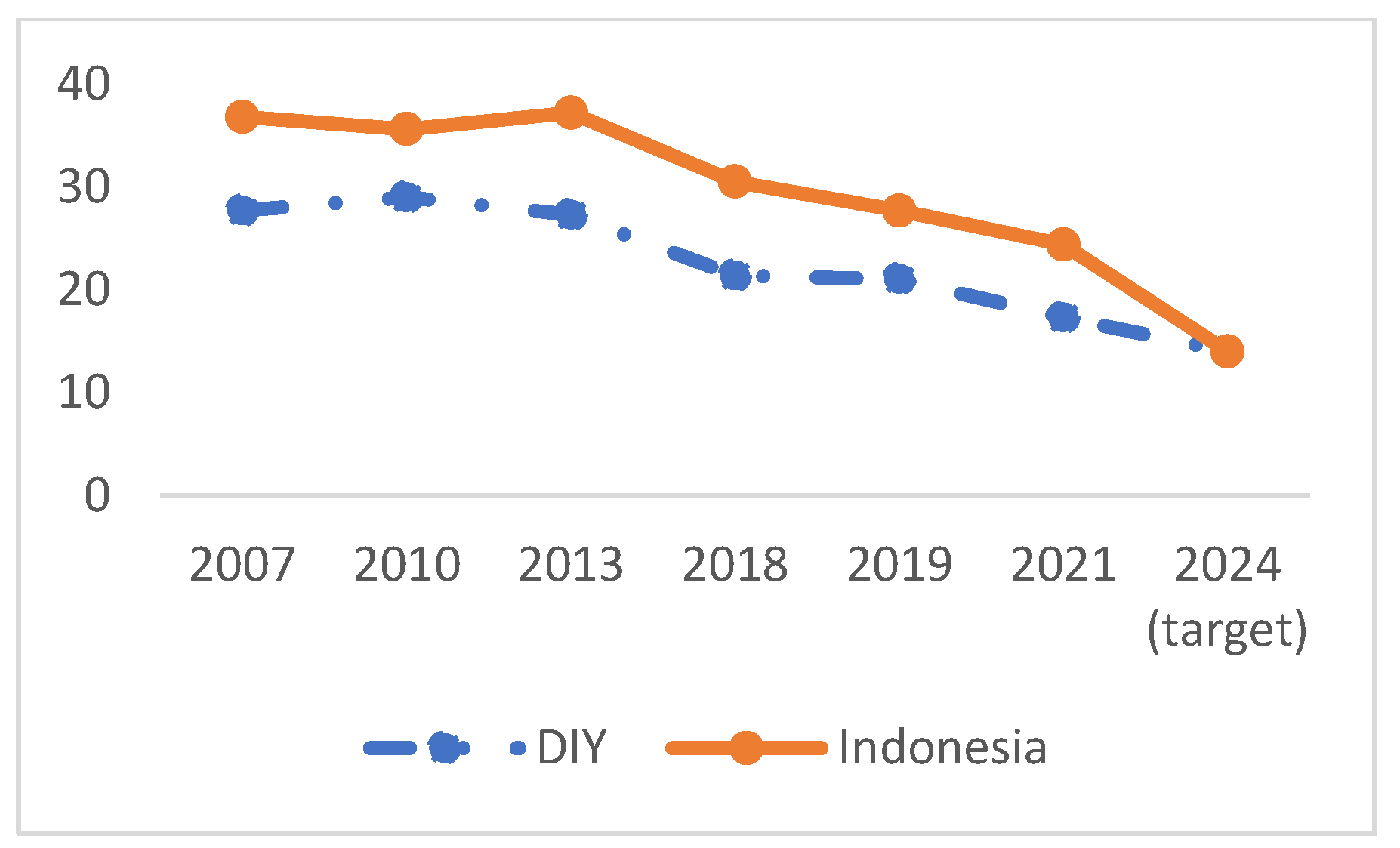
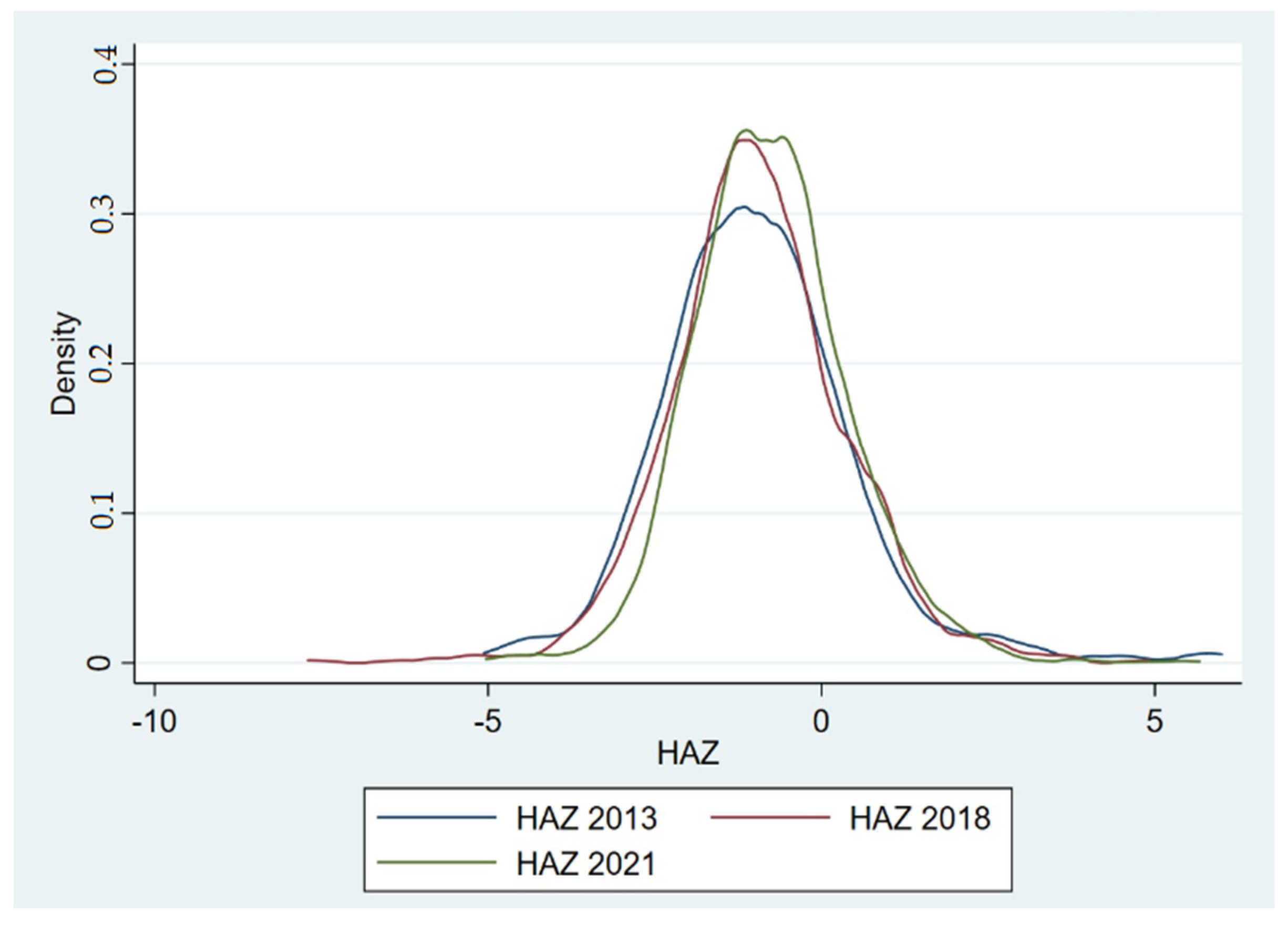
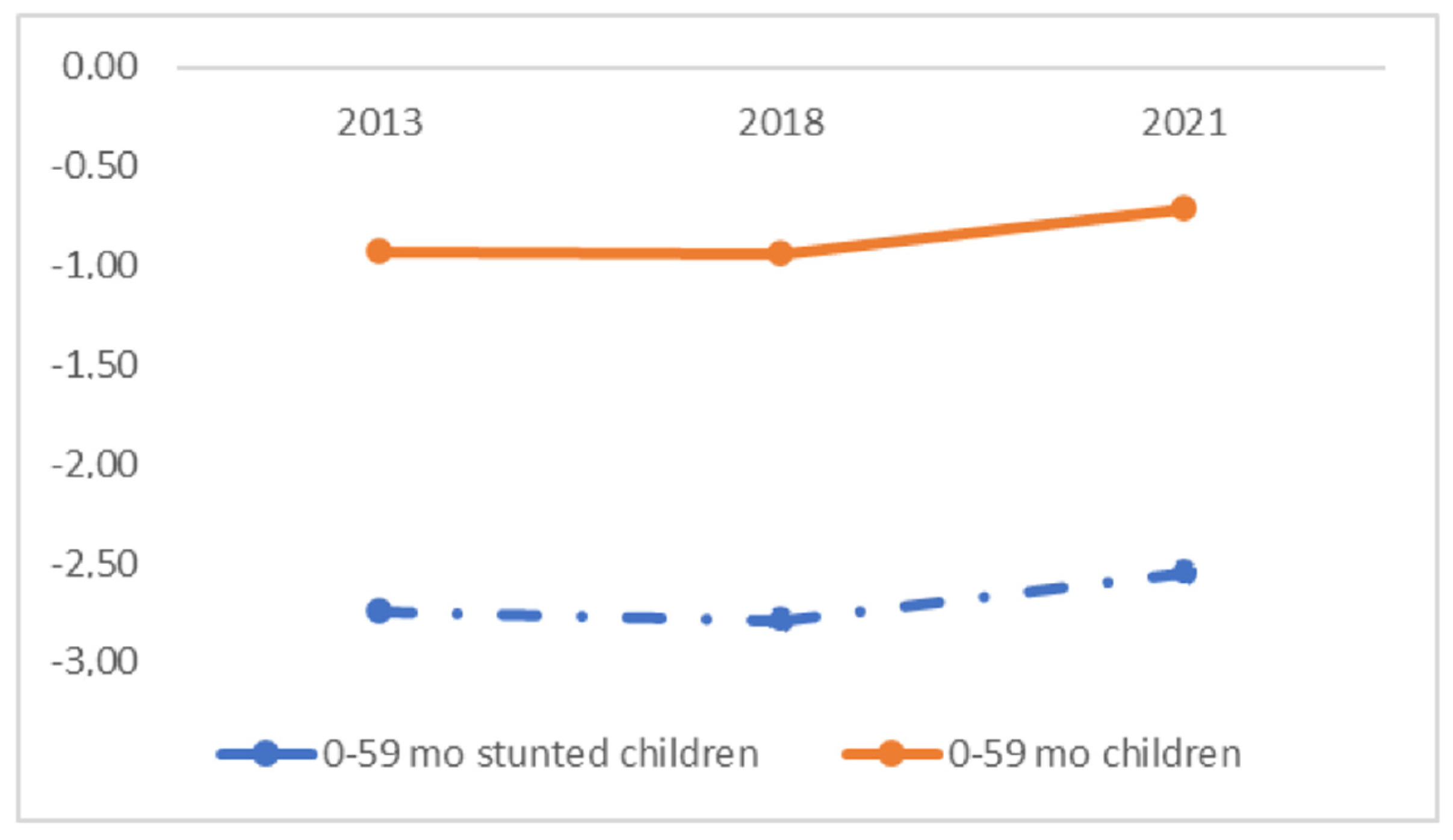
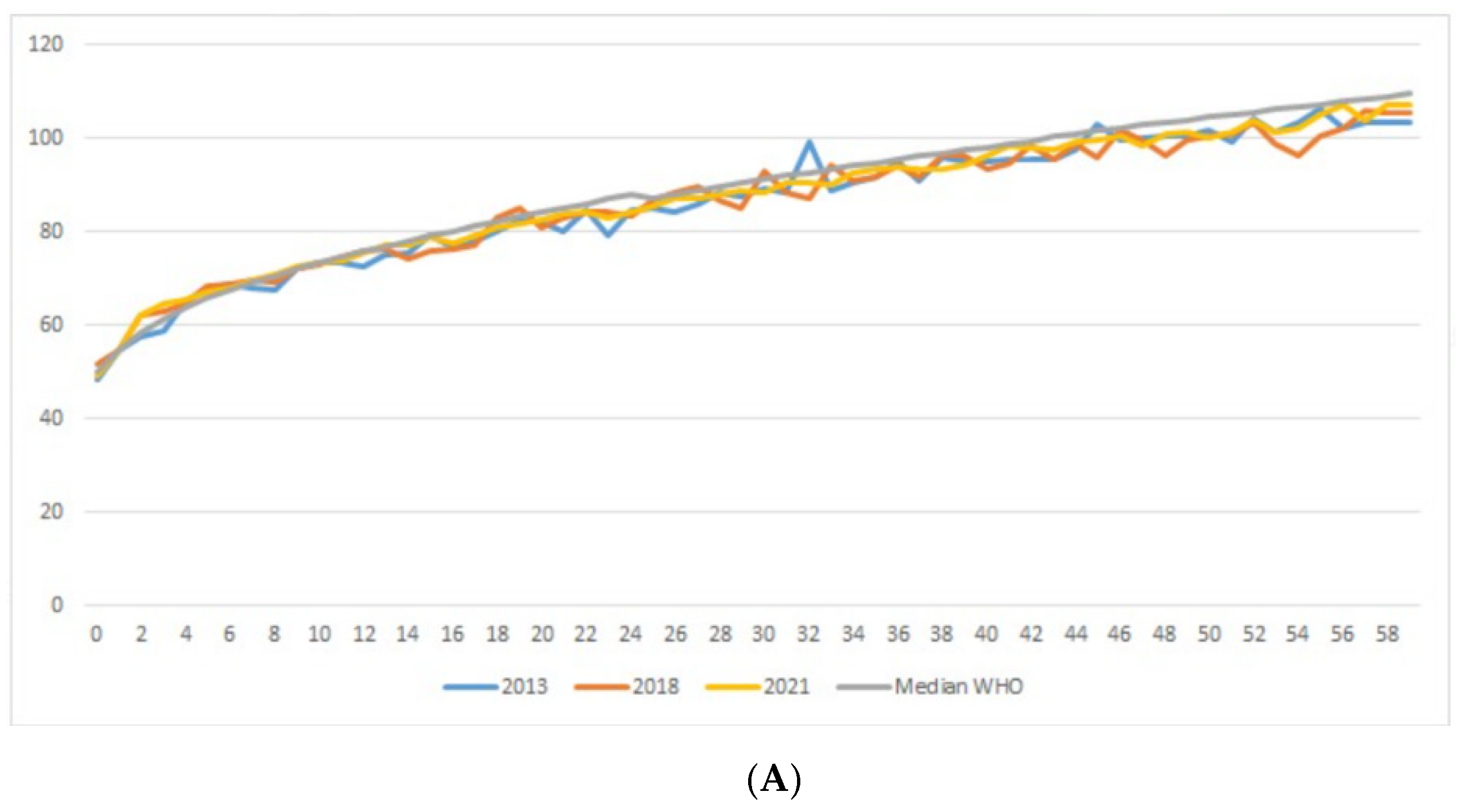
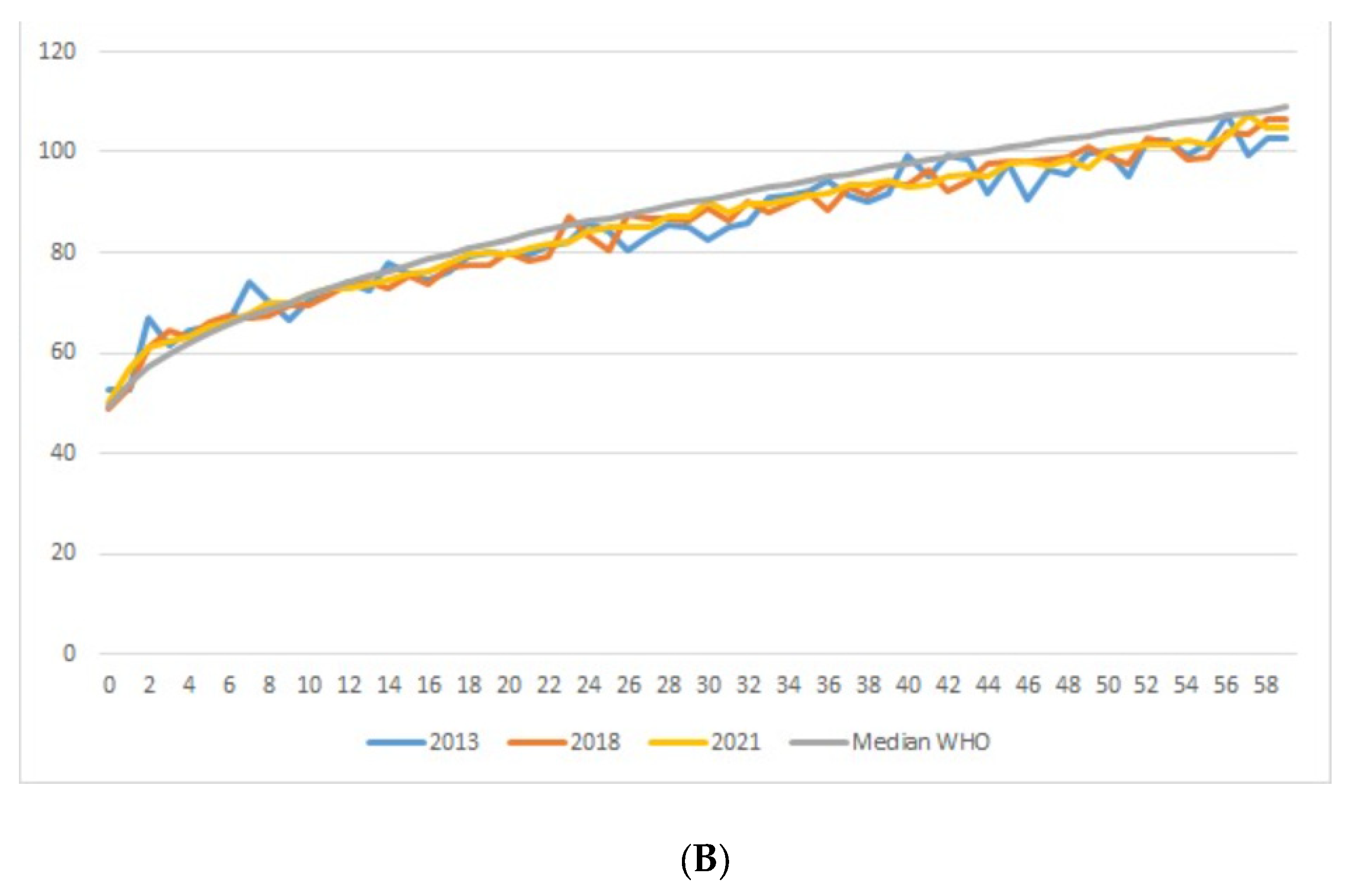
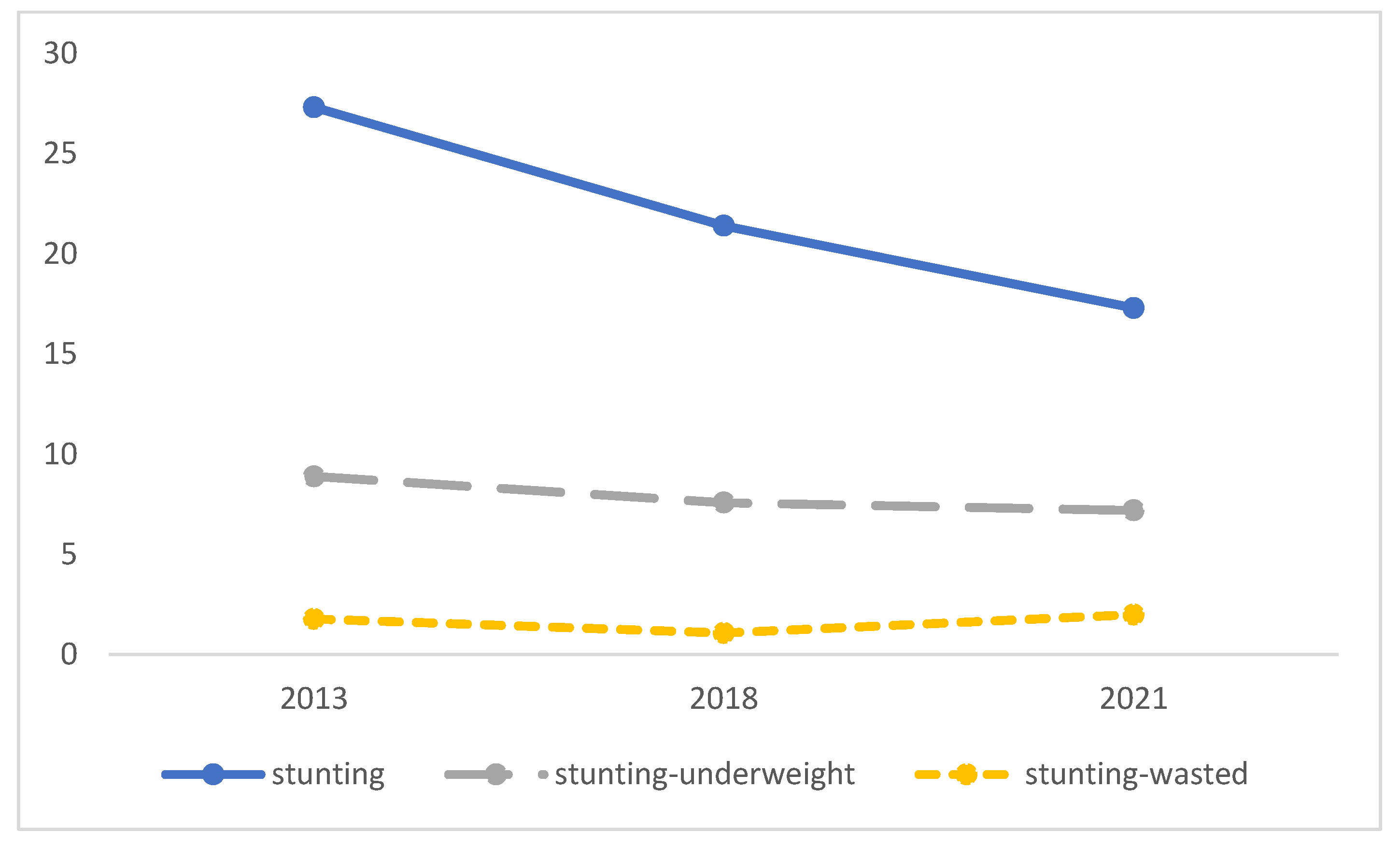
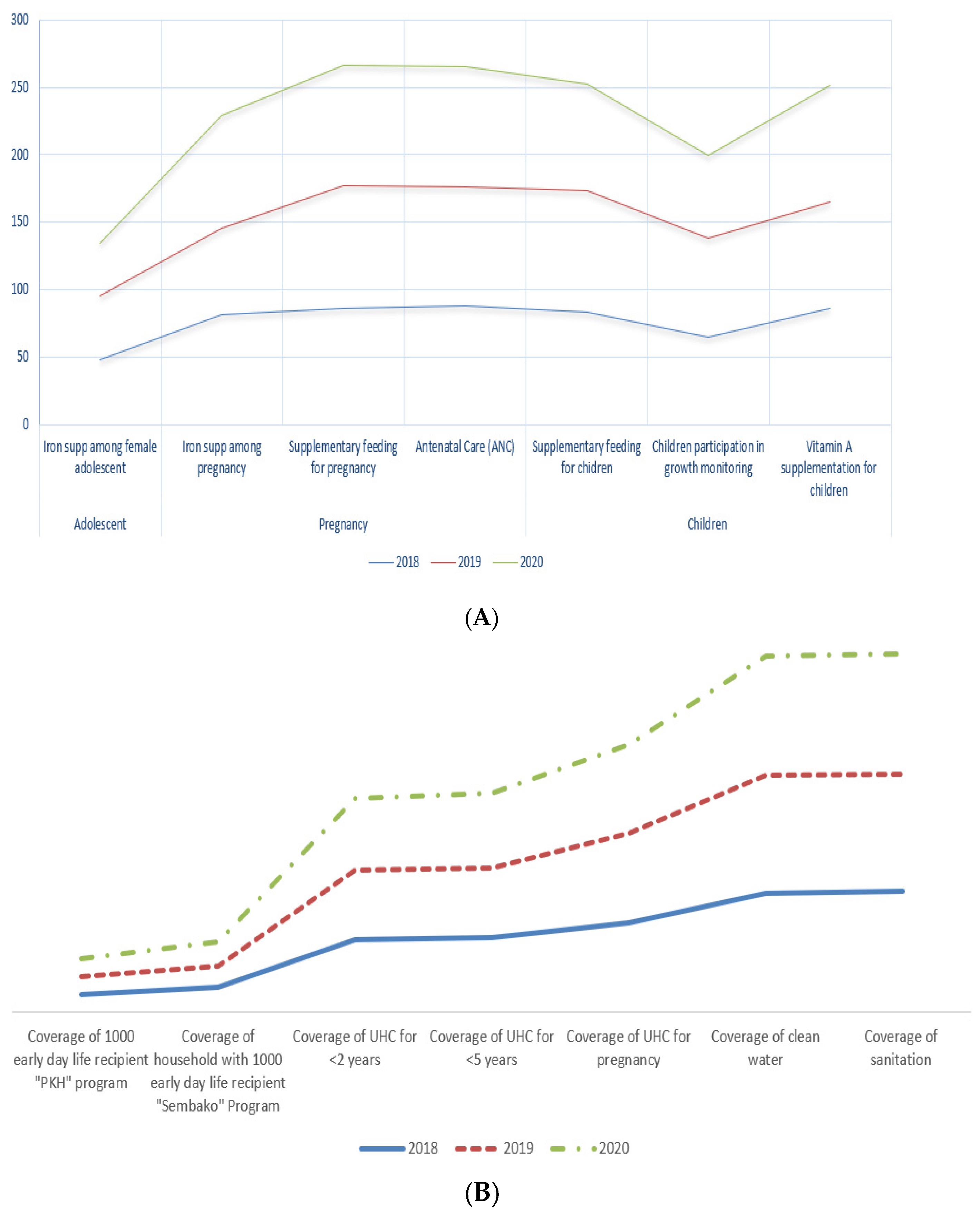
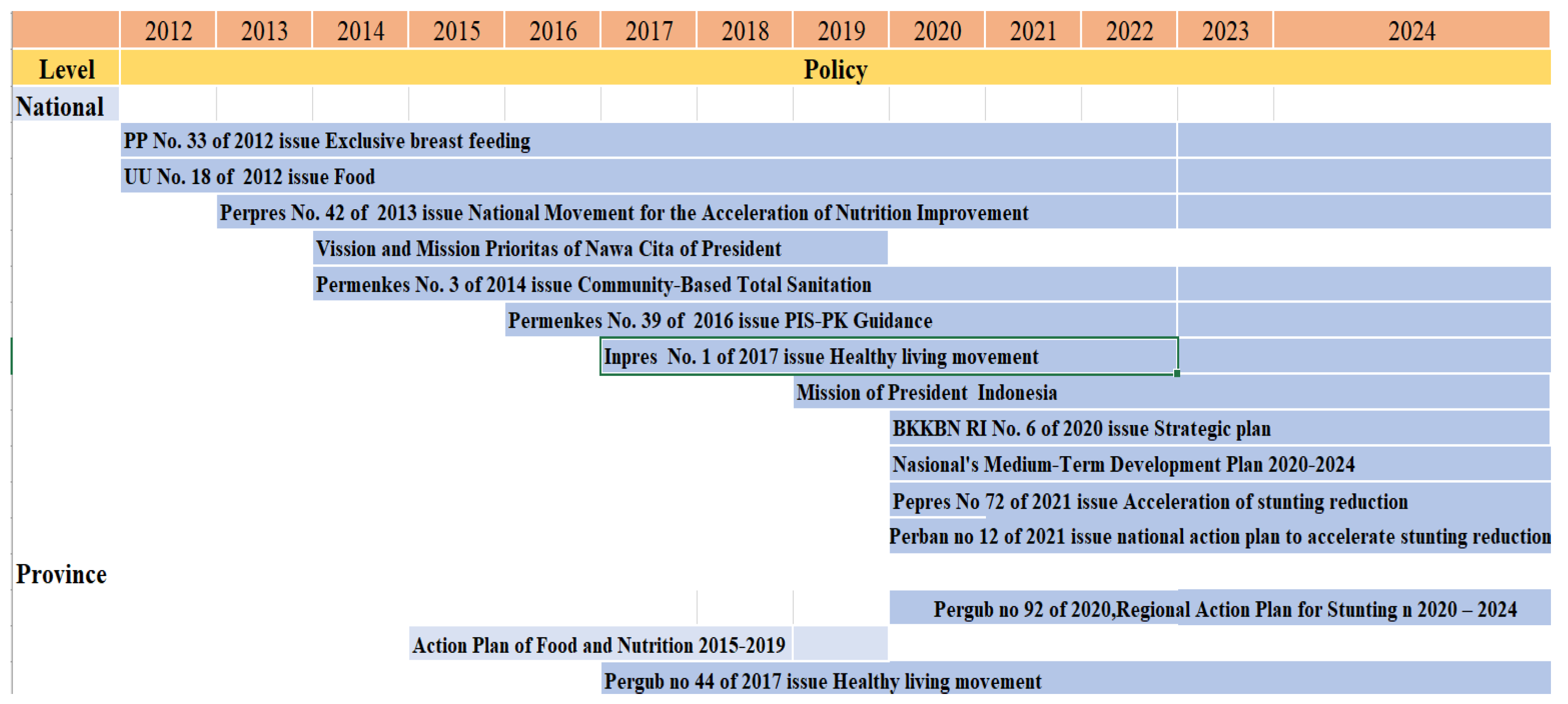
| Characteristics | 2013 (n = 795) | 2018 (n = 731) | 2021 (n = 2877) | Total | ||||
|---|---|---|---|---|---|---|---|---|
| n | % | n | % | n | % | n | % | |
| Age (mo) | ||||||||
| <6 | 54 | 7.7 | 60 | 8.2 | 168 | 5.8 | 282 | 6.5 |
| 6–23 | 201 | 28.5 | 210 | 28.7 | 876 | 30.5 | 1287 | 29.8 |
| 24–59 | 450 | 63.8 | 461 | 63.1 | 1833 | 63.7 | 2744 | 63.6 |
| District | ||||||||
| Kulon Progo | 174 | 24.7 | 142 | 11.5 | 450 | 11.2 | 592 | 11.3 |
| Bantul | 125 | 17.7 | 164 | 24.5 | 737 | 28.4 | 901 | 27.5 |
| Gunung Kidul | 125 | 17.7 | 149 | 18.1 | 578 | 17.5 | 727 | 17.8 |
| Sleman | 155 | 22.0 | 189 | 33.6 | 692 | 32.9 | 881 | 33.3 |
| Yogyakarta City | 126 | 17.9 | 87 | 10.2 | 420 | 9.9 | 507 | 10.1 |
| Gender | ||||||||
| Male | 377 | 53.5 | 385 | 51.8 | 1463 | 50.6 | 1848 | 51.2 |
| Female | 328 | 46.5 | 346 | 48.17 | 1414 | 49.4 | 1760 | 48.8 |
| Setting | ||||||||
| Urban | 529 | 75.1 | 497 | 74.8 | 1997 | 75.7 | 2494 | 75.21 |
| Rural | 176 | 24.9 | 234 | 25.3 | 880 | 24.4 | 1114 | 24.8 |
Publisher’s Note: MDPI stays neutral with regard to jurisdictional claims in published maps and institutional affiliations. |
© 2022 by the authors. Licensee MDPI, Basel, Switzerland. This article is an open access article distributed under the terms and conditions of the Creative Commons Attribution (CC BY) license (https://creativecommons.org/licenses/by/4.0/).
Share and Cite
Siswati, T.; Iskandar, S.; Pramestuti, N.; Raharjo, J.; Rubaya, A.K.; Wiratama, B.S. Drivers of Stunting Reduction in Yogyakarta, Indonesia: A Case Study. Int. J. Environ. Res. Public Health 2022, 19, 16497. https://doi.org/10.3390/ijerph192416497
Siswati T, Iskandar S, Pramestuti N, Raharjo J, Rubaya AK, Wiratama BS. Drivers of Stunting Reduction in Yogyakarta, Indonesia: A Case Study. International Journal of Environmental Research and Public Health. 2022; 19(24):16497. https://doi.org/10.3390/ijerph192416497
Chicago/Turabian StyleSiswati, Tri, Slamet Iskandar, Nova Pramestuti, Jarohman Raharjo, Agus Kharmayana Rubaya, and Bayu Satria Wiratama. 2022. "Drivers of Stunting Reduction in Yogyakarta, Indonesia: A Case Study" International Journal of Environmental Research and Public Health 19, no. 24: 16497. https://doi.org/10.3390/ijerph192416497
APA StyleSiswati, T., Iskandar, S., Pramestuti, N., Raharjo, J., Rubaya, A. K., & Wiratama, B. S. (2022). Drivers of Stunting Reduction in Yogyakarta, Indonesia: A Case Study. International Journal of Environmental Research and Public Health, 19(24), 16497. https://doi.org/10.3390/ijerph192416497






